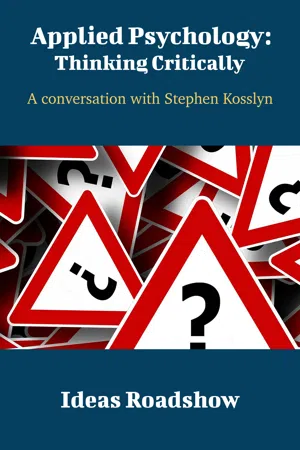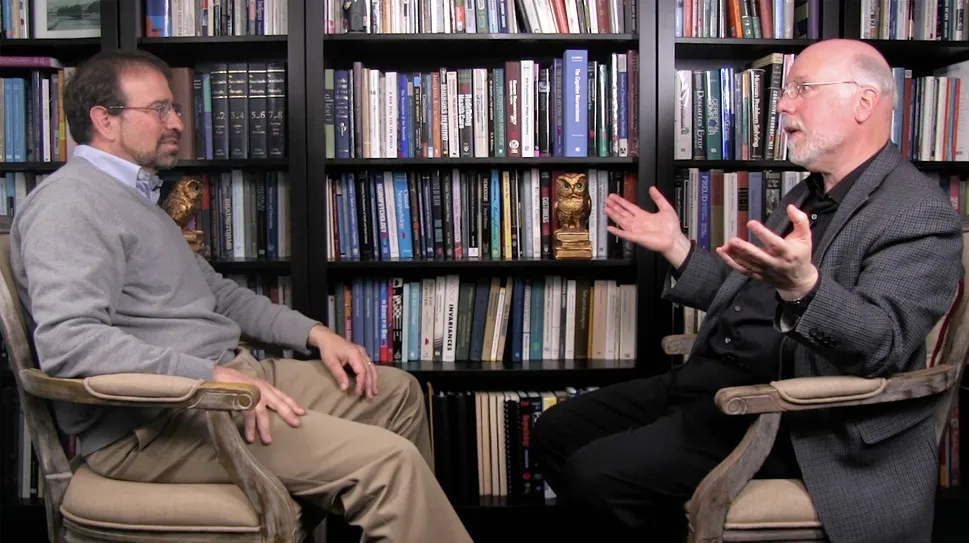![]()
The Conversation
![]()
I. Only Communicate
The PowerPointing Professor
HB: I want to start off by asking you about the motivations that led you to co-write this book, your motivations to popularize modern ideas of cognitive science and neuroscience that haven’t been appreciated by the general public and that led to the development of your new theory.
SK: My career arc is, I think, fairly typical of a certain kind of academic, where one starts off focused on basic questions, does a lot of basic research, fills pages of journals and so forth. It’s all very satisfying up to a point. And then, at least in my case, I started thinking about applications. What can we do with this? I have a practical turn of mind much of the time, which has led me to leave standard academia and work for a start-up trying to do something massive. But it has also led me to think about applications of basic research.
I started off with a book on PowerPoint. I had the honour of being chair of my department, at Harvard, which required me to be at every talk that was given there.
After a while, I started noticing that some of the world’s experts on cognitive science were not wonderful at presenting their ideas; they were violating the kinds of psychological principles you presumably learn as an undergraduate. So I started taking notes on how they were presenting rather than what they were presenting.
That led to this first book I did on PowerPoint, Clear and to the Point. It consists of eight principles that are harvested directly from the basic science literature; I show how you can use them to a good end, to present material in a way that is clear and compelling. That general approach, of trying to see what’s in the scientific literature that’s low-hanging fruit and show how it could be put to use, led me to conceive of the book, Top Brain, Bottom Brain.
HB: What was the response of your colleagues and the wider professional world to the book on PowerPoint?
SK: There was very little response, but I do occasionally get an email from somebody. I remember one in particular: I had reviewed the psychological literature on effectiveness of various kinds of graphic communication—this was all in endnotes of the book I wrote—and somebody had written saying they had overlooked those and didn’t realize that I actually had some real scholarship in the book. I thought that was striking, that they were more interested in the literature review than actually putting the material to use.
HB: That kind of defeats the point.
SK: Well, it was interesting.
HB: I haven’t read this book. But I was struck by, from my perspective, the seeming incongruity of someone in your position writing a book on PowerPoint, to the extent that I actually had to do a search to determine, Is this the same Stephen Kosslyn?
SK: Yes. I’ve actually now written two books on PowerPoint, so it became something of a hobby.
HB: Have you noticed any change in academe, in terms of the quality of presentations? Is there any sense that this book has had some sort of an impact?
SK: No, not that I’ve noticed. But hope springs eternal; and if we wait long enough the ideas may get out there.
Don Norman had written a book, The Design of Everyday Things, well in advance of the first book I wrote on PowerPoint, where he came up with a set of principles that overlap a bit with mine. I didn’t know that at the time I wrote my book, to my embarrassment. His book has been widely read, but I still see violations of those principles everyday. For example, when you leave this building, you’ll see that the door handles invite you to pull, when in fact you need to push to get out. It’s a classic violation of his principle of affordances: the way that properties of objects invite you to interact with them. It takes a long time for these kinds of ideas to percolate, but you do what you can.
![]()
- Are you surprised that a Harvard dean would write books on using PowerPoint and effective communication?
- What do you think Stephen means, exactly, when he says, “They were violating the kinds of psychological principles you presumably learn as an undergraduate”?
![]()
II. Top Brain, Bottom Brain
A new theory of personality
HB: Moving now to Top Brain, Bottom Brain. Did you have similar motivations in terms of spreading the message to a broader group of people?
SK: Well, it’s more than spreading the message; it’s actually figuring out what the message is.
Many researchers just want to find things out for their own sake; that’s what basic science is all about—and in psychology there are many scientists who want to know how perception works, how memory works, whatever—just to figure it out. But once you know that, you can then say, “Well, since we know that similar coloured objects tend to group together, we can use that fact to group labels in different colours with segments of a bar graph that are in corresponding colours”, for example. You can put that knowledge to work.
With respect to Top Brain, Bottom Brain, the basic science concerns these two big parts of the brain: one that’s on the top, and one that is under your temples below. I should specify that I’m talking about the cortex, here, the outer covering. I’m not talking about structures deep inside the brain, such as the amygdala.
It’s been known for a long time that these two major parts of the brain have very different functions. There’s quite a bit of basic science; some of it involves monkeys, a lot of it involves studying humans who have had strokes that prevent blood flow to certain areas of the brain, so you get brain cells that die, and then you get behavioural deficits that accompany that loss. Then there is neuroimaging, seeing what parts of the brain are activated when people engage in different cognitive tasks.
There is a large amount of data that documents that there are differences between what the top parts of the brain and bottom parts of the brain do, but nobody had really thought about what the implications of those basic science results are for everyday life, for the kinds of things that ordinary people care about.
So that was the project: to think about what we had learned. In particular, my colleagues and I, Gregoire Borst and Bill Thompson, did a big meta-analysis—an analysis of analyses—of the neuroscientific literature, using human data, to try to figure out how best to characterize what the top brain and bottom brain do. Once we had that in hand, it occurred to me that there were some interesting things one could do with that, in terms of personality.
That was a novel approach. The story we tell in the book is definitely a theory; it’s definitely a set of structured hypotheses. It has not been tested in detail, so I don’t recommend just accepting it as it is. But it is certainly plausible enough, because it is based on these findings. It is plausible enough to take seriously and think about.
HB: Let’s back up and let’s specify the differences between top brain and bottom brain. Let’s make sure that everyone is aware of the starting point, as it were, for the development of this theory. What are the differences between top-brain processes and bottom-brain processes?
SK: The meta-analysis that we did, this analysis of analyses, revealed that the best way to characterize the top brain is in terms of setting up and executing plans, such as deciding how you are going to thread your way through a crowd or cook a complex meal. Doing this requires delineating a sequence of things to do, monitoring what happens as you do them, then updating the plans. The top brain is responsible for such serial kinds of processes that occur over time, which are driven by plans where you specify a specific goal.
The bottom brain is not so muc...

